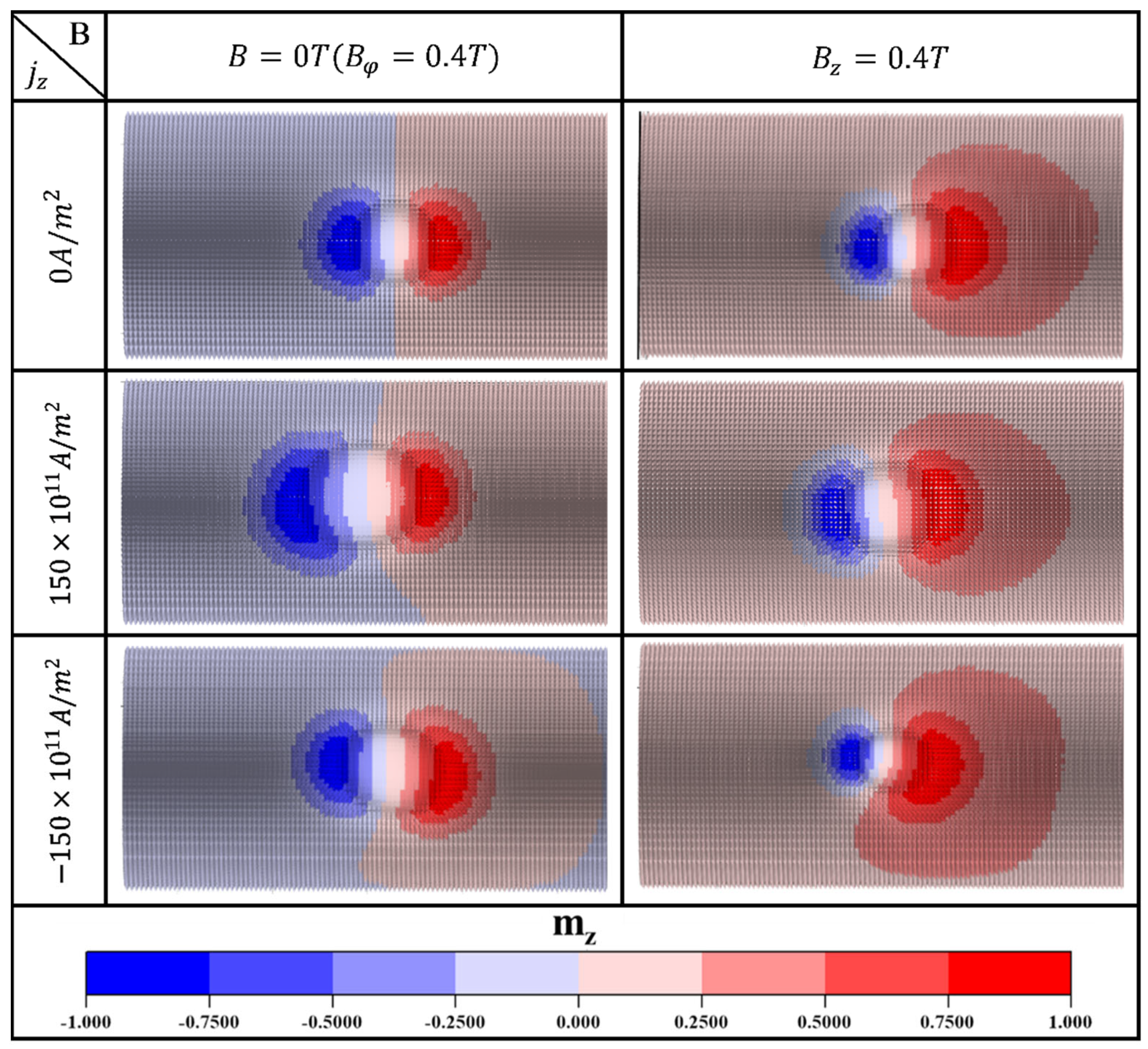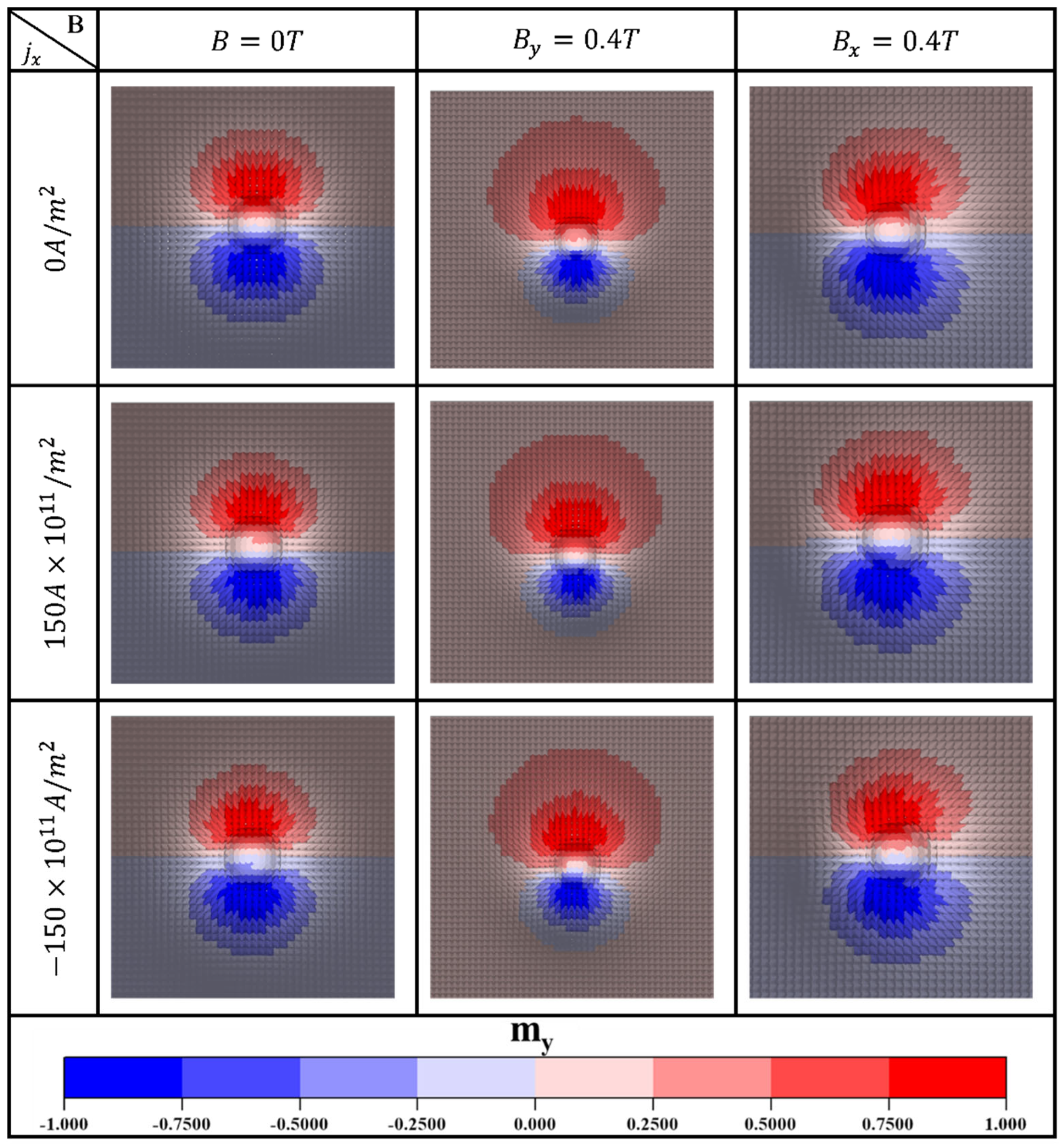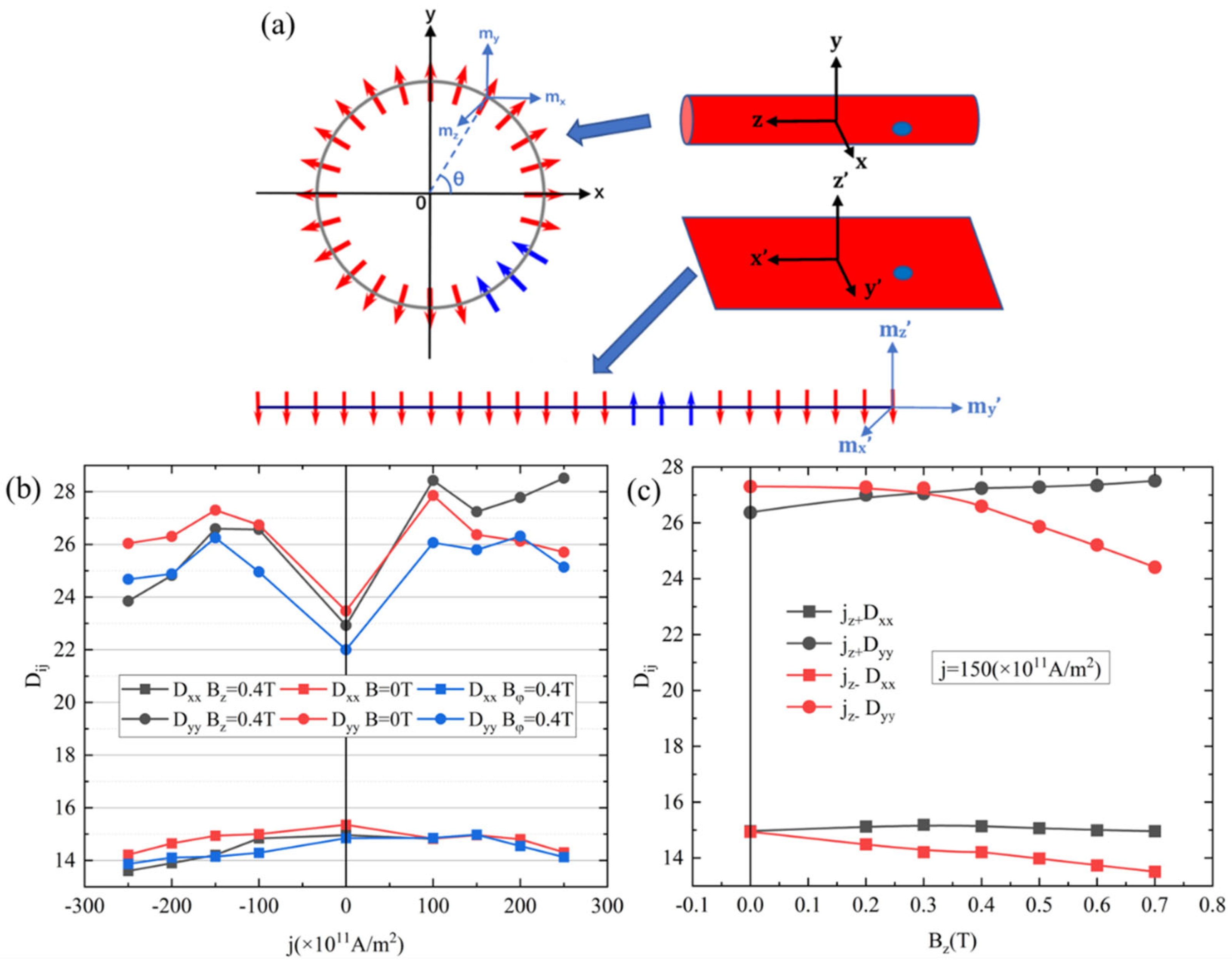Asymmetric Motion of Magnetic Skyrmions in Ferromagnetic Nanotubes Induced by a Magnetic Field
Abstract
:1. Introduction
2. Materials and Methods
3. Results
3.1. Velocity
3.2. Shape
3.3. Role of the Curvature Effect
4. Discussion
5. Conclusions
Author Contributions
Funding
Institutional Review Board Statement
Informed Consent Statement
Data Availability Statement
Conflicts of Interest
References
- Roessler, U.K.; Bogdanov, A.N.; Pfleiderer, C. Spontaneous skyrmion ground states in magnetic metals. Nature 2006, 442, 797–801. [Google Scholar] [CrossRef] [PubMed] [Green Version]
- Muhlbauer, S. Skyrmion lattice in a chiral magnet (February, pg 915, 2009). Science 2011, 333, 1381. [Google Scholar]
- Chen, G.; Mascaraque, A.; N’Diaye, A.T.; Schmid, A.K. Room temperature skyrmion ground state stabilized through interlayer exchange coupling. Appl. Phys. Lett. 2015, 106, 242404. [Google Scholar] [CrossRef]
- Yu, X.Z.; Onose, Y.; Kanazawa, N.; Park, J.-H.; Han, J.H.; Matsui, Y.; Nagaosa, N.; Tokura, Y. Real-space observation of a two-dimensional skyrmion crystal. Nature 2010, 465, 901–904. [Google Scholar] [CrossRef]
- Legrand, W.; Maccariello, D.; Reyren, N.; Garcia, K.; Moutafis, C.; Moreau-Luchaire, C.; Collin, S.; Bouzehouane, K.; Cros, V.; Fert, A. Room-Temperature Current-Induced Generation and Motion of sub-100 nm Skyrmions. Nano Lett. 2017, 17, 2703–2712. [Google Scholar] [CrossRef] [PubMed] [Green Version]
- Di, K.; Zhang, V.L.; Lim, H.S.; Ng, S.C.; Kuok, M.H.; Yu, J.; Yoon, J.; Qiu, X.; Yang, H. Direct Observation of the Dzyaloshinskii-Moriya Interaction in a Pt/Co/Ni Film. Phys. Rev. Lett. 2015, 114, 047201. [Google Scholar] [CrossRef] [PubMed]
- Tanigaki, T.; Shibata, K.; Kanazawa, N.; Yu, X.; Onose, Y.; Park, H.S.; Shindo, D.; Tokura, Y. Real-Space Observation of Short-Period Cubic Lattice of Skyrmions in MnGe. Nano Lett. 2015, 15, 5438–5442. [Google Scholar] [CrossRef] [Green Version]
- Guslienko, K.Y. Skyrmion State Stability in Magnetic Nanodots with Perpendicular Anisotropy. IEEE Magn. Lett. 2015, 6, 1–4. [Google Scholar] [CrossRef]
- Zelent, M.; Tóbik, J.; Krawczyk, M.; Guslienko, K.Y.; Mruczkiewicz, M. Bi-Stability of Magnetic Skyrmions in Ultrathin Multilayer Nanodots Induced by Magnetostatic Interaction. Phys. Status Solidi (RRL) Rapid Res. Lett. 2017, 11, 1700259. [Google Scholar] [CrossRef] [Green Version]
- Lonsky, M.; Hoffmann, A. Dynamic excitations of chiral magnetic textures. APL Mater. 2020, 8, 100903. [Google Scholar] [CrossRef]
- Kravchuk, V.P.; Rößler, U.K.; Volkov, O.M.; Sheka, D.D.; van den Brink, J.; Makarov, D.; Fuchs, H.; Fangohr, H.; Gaididei, Y. Topologically stable magnetization states on a spherical shell: Curvature-stabilized skyrmions. Phys. Rev. B 2016, 94, 144402. [Google Scholar] [CrossRef] [Green Version]
- Schulz, T.; Ritz, R.; Bauer, A.; Halder, M.; Wagner, M.; Franz, C.; Pfleiderer, C.; Everschor-Sitte, K.; Garst, M.; Rosch, A. Emergent electrodynamics of skyrmions in a chiral magnet. Nat. Phys. 2012, 8, 301–304. [Google Scholar] [CrossRef] [Green Version]
- Yang, S.-H.; Ryu, K.-S.; Parkin, S. Domain-wall velocities of up to 750 m s−1 driven by exchange-coupling torque in synthetic antiferromagnets. Nat. Nanotechnol. 2015, 10, 221–226. [Google Scholar] [CrossRef] [PubMed]
- Kiselev, N.S.; Bogdanov, A.N.; Schäfer, R.; Rößler, U.K. Chiral skyrmions in thin magnetic films: New objects for magnetic storage technologies? J. Phys. D Appl. Phys. 2011, 44, 392001. [Google Scholar] [CrossRef] [Green Version]
- Yi-Zhou, L.; Jiadong, Z. Overview and outlook of magnetic skyrmions. Acta Phys. Sin. 2018, 67, 131201. [Google Scholar] [CrossRef]
- Jiang, W.; Zhang, X.; Yu, G.; Zhang, W.; Wang, X.; Jungfleisch, M.B.; Pearson, J.E.; Cheng, X.; Heinonen, O.; Wang, K.L.; et al. Direct observation of the skyrmion Hall effect. Nat. Phys. 2016, 13, 162–169. [Google Scholar] [CrossRef]
- Iwasaki, J.; Mochizuki, M.; Nagaosa, N. Universal current-velocity relation of skyrmion motion in chiral magnets. Nat. Commun. 2013, 4, 1463. [Google Scholar] [CrossRef]
- Wang, X.; Wang, X.; Wang, C.; Yang, H.; Cao, Y.; Yan, P. Current-induced skyrmion motion on magnetic nanotubes. J. Phys. D Appl. Phys. 2019, 52, 225001. [Google Scholar] [CrossRef] [Green Version]
- Huo, X.; Liu, Y. The stability of a skyrmion in a nanotube. New J. Phys. 2019, 21, 093024. [Google Scholar] [CrossRef]
- Fernández-Pacheco, A.; Streubel, R.; Fruchart, O.; Hertel, R.; Fischer, P.; Cowburn, R.P. Three-dimensional nanomagnetism. Nat. Commun. 2017, 8, 15756. [Google Scholar] [CrossRef] [Green Version]
- Pylypovskyi, O.V.; Kravchuk, V.P.; Sheka, D.D.; Makarov, D.; Schmidt, O.G.; Gaididei, Y. Coupling of Chiralities in Spin and Physical Spaces: The Möbius Ring as a Case Study. Phys. Rev. Lett. 2015, 114, 197204. [Google Scholar] [CrossRef] [PubMed] [Green Version]
- Vojkovic, S.; Carvalho-Santos, V.L.; Fonseca, J.M.; Nunez, A.S. Vortex-antivortex pairs induced by curvature in toroidal nanomagnets. J. Appl. Phys. 2017, 121, 113906. [Google Scholar] [CrossRef] [Green Version]
- Yang, J.; Kim, J.; Kim, B.; Cho, Y.-J.; Lee, J.-H.; Kim, S.-K. Vortex-chirality-dependent standing spin-wave modes in soft magnetic nanotubes. J. Appl. Phys. 2018, 123, 033901. [Google Scholar] [CrossRef] [Green Version]
- Volkov, O.M.; Sheka, D.D.; Gaididei, Y.; Kravchuk, V.P.; Rößler, U.K.; Fassbender, J.; Makarov, D. Mesoscale Dzyaloshinskii-Moriya interaction: Geometrical tailoring of the magnetochirality. Sci. Rep. 2018, 8, 866. [Google Scholar] [CrossRef] [Green Version]
- Volkov, O.M.; Kákay, A.; Kronast, F.; Mönch, I.; Mawass, M.-A.; Fassbender, J.; Makarov, D. Experimental Observation of Exchange-Driven Chiral Effects in Curvilinear Magnetism. Phys. Rev. Lett. 2019, 123, 077201. [Google Scholar] [CrossRef]
- Volkov, O.M.; Kronast, F.; Mönch, I.; Mawass, M.A.; Kákay, A.; Fassbender, J.; Makarov, D. Experimental and theoretical study of curvature effects in parabolic nanostripes. Phys. Status Solidi (RRL) Rapid Res. Lett. 2019, 13, 1800309. [Google Scholar] [CrossRef] [Green Version]
- Giordano, M.C.; Baumgaertl, K.; Escobar Steinvall, S.; Gay, J.; Vuichard, M.; Fontcuberta i Morral, A.; Grundler, D. Plasma-enhanced atomic layer deposition of nickel nanotubes with low resistivity and coherent magnetization dynamics for 3D spintronics. ACS Appl. Mater. Interfaces 2020, 12, 40443–40452. [Google Scholar] [CrossRef]
- Phatak, C.; Miller, C.S.; Thompson, Z.; Gulsoy, E.B.; Petford-Long, A.K. Curved Three-Dimensional Cobalt Nanohelices for Use in Domain Wall Device Applications. ACS Appl. Nano Mater. 2020, 3, 6009–6016. [Google Scholar] [CrossRef]
- Otálora, J.; López, J.; Landeros, P.; Vargas, P.; Núñez, A. Breaking of chiral symmetry in vortex domain wall propagation in ferromagnetic nanotubes. J. Magn. Magn. Mater. 2013, 341, 86–92. [Google Scholar] [CrossRef]
- Yang, M.; Yin, B.; Li, Z.; Zeng, X.; Yan, M. Magnonic activity of ferromagnetic nanocylinders. Phys. Rev. B 2021, 103, 094404. [Google Scholar] [CrossRef]
- Yan, M.; Andreas, C.; Kákay, A.; García-Sánchez, F.; Hertel, R. Chiral symmetry breaking and pair-creation mediated Walker breakdown in magnetic nanotubes. Appl. Phys. Lett. 2012, 100, 252401. [Google Scholar] [CrossRef] [Green Version]
- Otálora, J.A.; Yan, M.; Schultheiss, H.; Hertel, R.; Kákay, A. Curvature-Induced Asymmetric Spin-Wave Dispersion. Phys. Rev. Lett. 2016, 117, 227203. [Google Scholar] [CrossRef] [PubMed]
- Otálora, J.A.; Yan, M.; Schultheiss, H.; Hertel, R.; Kákay, A. Asymmetric spin-wave dispersion in ferromagnetic nanotubes induced by surface curvature. Phys. Rev. B 2017, 95, 184415. [Google Scholar] [CrossRef]
- Dastgeer, G.; Khan, M.F.; Nazir, G.; Afzal, A.M.; Aftab, S.; Akbar, K.; Chun, S.-H.; Eom, J. Surface spin accumulation due to the inverse spin Hall effect in WS 2 crystals. 2D Mater. 2018, 6, 011007. [Google Scholar] [CrossRef]
- Sharif, S.; Murtaza, G.; Khan, M.A.; Sadaf, A.; Al-Muhimeed, T.I.; Nazir, G. Tailoring the multiferroic properties of BiFeO3 by low energy ions implantation. J. Electroceram. 2021, 1–18. [Google Scholar] [CrossRef]
- Afzal, A.M.; Khan, M.F.; Nazir, G.; Dastgeer, G.; Aftab, S.; Akhtar, I.; Seo, Y.; Eom, J. Gate Modulation of the Spin-orbit Interaction in Bilayer Graphene Encapsulated by WS2 films. Sci. Rep. 2018, 8, 3412. [Google Scholar] [CrossRef]
- Khan, M.F.; Kim, H.; Nazir, G.; Jung, S.; Eom, J. Layer dependent magnetoresistance of vertical MoS2 magnetic tunnel junctions. Nanoscale 2018, 10, 16703–16710. [Google Scholar] [CrossRef]
- Vansteenkiste, A.; Leliaert, J.; Dvornik, M.; Helsen, M.; Garcia-Sanchez, F.; Van Waeyenberge, B. The design and verification of MuMax3. AIP Adv. 2014, 4, 107133. [Google Scholar] [CrossRef] [Green Version]
- Vansteenkiste, A.; Van de Wiele, B. MuMax: A new high-performance micromagnetic simulation tool. J. Magn. Magn. Mater. 2011, 323, 2585–2591. [Google Scholar] [CrossRef] [Green Version]
- Zhang, S.; Li, Z. Roles of Nonequilibrium Conduction Electrons on the Magnetization Dynamics of Ferromagnets. Phys. Rev. Lett. 2004, 93, 127204. [Google Scholar] [CrossRef] [Green Version]
- Gilbert, T.L. A Lagrangian formulation of the gyromagnetic equation of the magnetization field. Phys. Rev. 1955, 100, 1243. [Google Scholar]
- Miltat, J.E.; Donahue, M.J. Numerical micromagnetics: Finite difference methods. Handb. Magn. Adv. Magn. Mater. 2007, 2, 742–764. [Google Scholar]
- Sampaio, J.; Cros, V.; Rohart, S.; Thiaville, A.; Fert, A. Nucleation, stability and current-induced motion of isolated magnetic skyrmions in nanostructures. Nat. Nanotechnol. 2013, 8, 839–844. [Google Scholar] [CrossRef] [PubMed]
- Valentin, J.; Kleinefeld, T.; Weller, D. Micromagnetic analysis of magnetization reversal in CoPt alloy films. J. Phys. D Appl. Phys. 1996, 29, 1111. [Google Scholar] [CrossRef]
- Kleinefeld, T.; Valentin, J.; Weller, D. Micromagnetic properties and domain dynamics of CoPt thin films. J. Magn. Magn. Mater. 1995, 148, 249–250. [Google Scholar] [CrossRef]
- Xie, K.; Sang, H. Three layers of skyrmions in the magnetic triple-layer structure without the Dzyaloshinsky-Moriya interaction. J. Appl. Phys. 2014, 116, 223901. [Google Scholar] [CrossRef]
- Nagaosa, N.; Tokura, Y. Topological properties and dynamics of magnetic skyrmions. Nat. Nanotechnol. 2013, 8, 899–911. [Google Scholar] [CrossRef]
- Stone, M. Magnus force on skyrmions in ferromagnets and quantum Hall systems. Phys. Rev. B 1996, 53, 16573. [Google Scholar] [CrossRef] [Green Version]
- Iwasaki, J.; Mochizuki, M.; Nagaosa, N. Current-induced skyrmion dynamics in constricted geometries. Nat. Nanotechnol. 2013, 8, 742–747. [Google Scholar] [CrossRef] [Green Version]
- Jiang, W.; Zhang, S.; Wang, X.; Phatak, C.; Wang, Q.; Zhang, W.; Jungfleisch, M.B.; Pearson, J.E.; Liu, Y.; Zang, J.; et al. Quantifying chiral exchange interaction for Néel-type skyrmions via Lorentz transmission electron microscopy. Phys. Rev. B 2019, 99, 104402. [Google Scholar] [CrossRef] [Green Version]
- Thiele, A.A. Steady-State Motion of Magnetic Domains. Phys. Rev. Lett. 1973, 30, 230–233. [Google Scholar] [CrossRef]
- Yang, J.; Kim, J.; Abert, C.; Suess, D.; Kim, S.-K. Stability of skyrmion formation and its abnormal dynamic modes in magnetic nanotubes. Phys. Rev. B 2020, 102, 094439. [Google Scholar] [CrossRef]
- Tomasello, R.; Martinez, E.; Zivieri, R.; Torres, L.; Carpentieri, M.; Finocchio, G. A strategy for the design of skyrmion racetrack memories. Sci. Rep. 2014, 4, 6784. [Google Scholar] [CrossRef] [PubMed] [Green Version]
- Yoo, M.-W.; Cros, V.; Kim, J.-V. Current-driven skyrmion expulsion from magnetic nanostrips. Phys. Rev. B 2017, 95, 184423. [Google Scholar] [CrossRef] [Green Version]






| Velocity(m/s) | ||||
|---|---|---|---|---|
| v// | 626 | 624 | 624 | |
| v⊥ | 278 | 274 | 276 | |
| v// | 626 | 622 | 622 | |
| v⊥ | 278 | 274 | 274 | |
Publisher’s Note: MDPI stays neutral with regard to jurisdictional claims in published maps and institutional affiliations. |
© 2022 by the authors. Licensee MDPI, Basel, Switzerland. This article is an open access article distributed under the terms and conditions of the Creative Commons Attribution (CC BY) license (https://creativecommons.org/licenses/by/4.0/).
Share and Cite
Bao, B.; Yang, M.; Yan, M. Asymmetric Motion of Magnetic Skyrmions in Ferromagnetic Nanotubes Induced by a Magnetic Field. Symmetry 2022, 14, 1195. https://doi.org/10.3390/sym14061195
Bao B, Yang M, Yan M. Asymmetric Motion of Magnetic Skyrmions in Ferromagnetic Nanotubes Induced by a Magnetic Field. Symmetry. 2022; 14(6):1195. https://doi.org/10.3390/sym14061195
Chicago/Turabian StyleBao, Bei, Mingming Yang, and Ming Yan. 2022. "Asymmetric Motion of Magnetic Skyrmions in Ferromagnetic Nanotubes Induced by a Magnetic Field" Symmetry 14, no. 6: 1195. https://doi.org/10.3390/sym14061195





